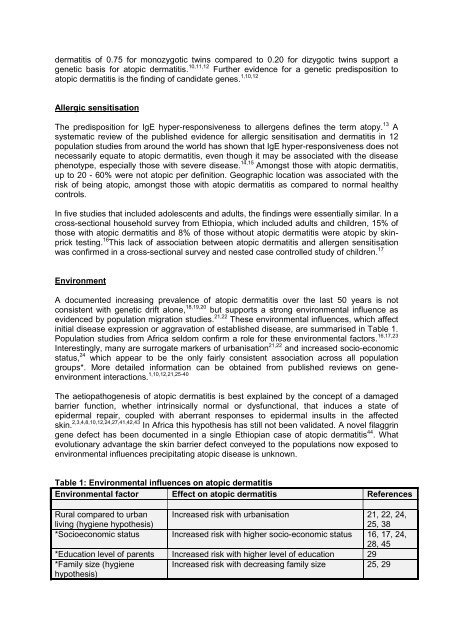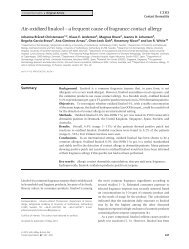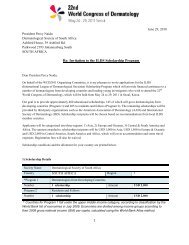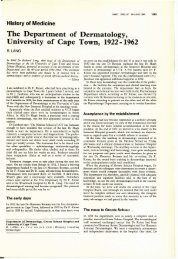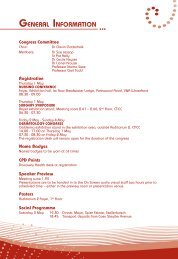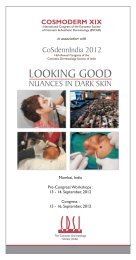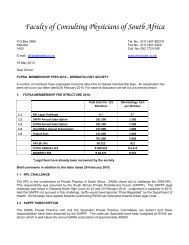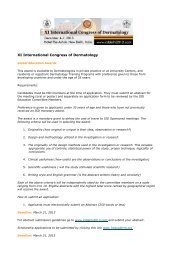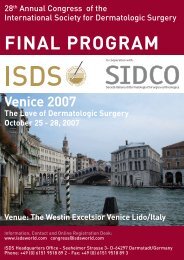Guidelines on the Management of Atopic Dermatitis ... - Dermatology
Guidelines on the Management of Atopic Dermatitis ... - Dermatology
Guidelines on the Management of Atopic Dermatitis ... - Dermatology
Create successful ePaper yourself
Turn your PDF publications into a flip-book with our unique Google optimized e-Paper software.
dermatitis <strong>of</strong> 0.75 for m<strong>on</strong>ozygotic twins compared to 0.20 for dizygotic twins support a<br />
genetic basis for atopic dermatitis. 10,11,12 Fur<strong>the</strong>r evidence for a genetic predispositi<strong>on</strong> to<br />
atopic dermatitis is <strong>the</strong> finding <strong>of</strong> candidate genes. 1,10,12<br />
Allergic sensitisati<strong>on</strong><br />
The predispositi<strong>on</strong> for IgE hyper-resp<strong>on</strong>siveness to allergens defines <strong>the</strong> term atopy. 13 A<br />
systematic review <strong>of</strong> <strong>the</strong> published evidence for allergic sensitisati<strong>on</strong> and dermatitis in 12<br />
populati<strong>on</strong> studies from around <strong>the</strong> world has shown that IgE hyper-resp<strong>on</strong>siveness does not<br />
necessarily equate to atopic dermatitis, even though it may be associated with <strong>the</strong> disease<br />
phenotype, especially those with severe disease. 14,15 Am<strong>on</strong>gst those with atopic dermatitis,<br />
up to 20 - 60% were not atopic per definiti<strong>on</strong>. Geographic locati<strong>on</strong> was associated with <strong>the</strong><br />
risk <strong>of</strong> being atopic, am<strong>on</strong>gst those with atopic dermatitis as compared to normal healthy<br />
c<strong>on</strong>trols.<br />
In five studies that included adolescents and adults, <strong>the</strong> findings were essentially similar. In a<br />
cross-secti<strong>on</strong>al household survey from Ethiopia, which included adults and children, 15% <strong>of</strong><br />
those with atopic dermatitis and 8% <strong>of</strong> those without atopic dermatitis were atopic by skinprick<br />
testing. 16 This lack <strong>of</strong> associati<strong>on</strong> between atopic dermatitis and allergen sensitisati<strong>on</strong><br />
was c<strong>on</strong>firmed in a cross-secti<strong>on</strong>al survey and nested case c<strong>on</strong>trolled study <strong>of</strong> children. 17<br />
Envir<strong>on</strong>ment<br />
A documented increasing prevalence <strong>of</strong> atopic dermatitis over <strong>the</strong> last 50 years is not<br />
c<strong>on</strong>sistent with genetic drift al<strong>on</strong>e, 18,19,20 but supports a str<strong>on</strong>g envir<strong>on</strong>mental influence as<br />
evidenced by populati<strong>on</strong> migrati<strong>on</strong> studies. 21,22 These envir<strong>on</strong>mental influences, which affect<br />
initial disease expressi<strong>on</strong> or aggravati<strong>on</strong> <strong>of</strong> established disease, are summarised in Table 1.<br />
Populati<strong>on</strong> studies from Africa seldom c<strong>on</strong>firm a role for <strong>the</strong>se envir<strong>on</strong>mental factors. 16,17,23<br />
Interestingly, many are surrogate markers <strong>of</strong> urbanisati<strong>on</strong> 21,22 and increased socio-ec<strong>on</strong>omic<br />
status, 24 which appear to be <strong>the</strong> <strong>on</strong>ly fairly c<strong>on</strong>sistent associati<strong>on</strong> across all populati<strong>on</strong><br />
groups*. More detailed informati<strong>on</strong> can be obtained from published reviews <strong>on</strong> geneenvir<strong>on</strong>ment<br />
interacti<strong>on</strong>s. 1,10,12,21,25-40<br />
The aetiopathogenesis <strong>of</strong> atopic dermatitis is best explained by <strong>the</strong> c<strong>on</strong>cept <strong>of</strong> a damaged<br />
barrier functi<strong>on</strong>, whe<strong>the</strong>r intrinsically normal or dysfuncti<strong>on</strong>al, that induces a state <strong>of</strong><br />
epidermal repair, coupled with aberrant resp<strong>on</strong>ses to epidermal insults in <strong>the</strong> affected<br />
skin. 2,3,4,8,10,12,24,27,41,42,43 In Africa this hypo<strong>the</strong>sis has still not been validated. A novel filaggrin<br />
gene defect has been documented in a single Ethiopian case <strong>of</strong> atopic dermatitis 44 . What<br />
evoluti<strong>on</strong>ary advantage <strong>the</strong> skin barrier defect c<strong>on</strong>veyed to <strong>the</strong> populati<strong>on</strong>s now exposed to<br />
envir<strong>on</strong>mental influences precipitating atopic disease is unknown.<br />
Table 1: Envir<strong>on</strong>mental influences <strong>on</strong> atopic dermatitis<br />
Envir<strong>on</strong>mental factor Effect <strong>on</strong> atopic dermatitis References<br />
Rural compared to urban<br />
living (hygiene hypo<strong>the</strong>sis)<br />
Increased risk with urbanisati<strong>on</strong> 21, 22, 24,<br />
25, 38<br />
*Socioec<strong>on</strong>omic status Increased risk with higher socio-ec<strong>on</strong>omic status 16, 17, 24,<br />
28, 45<br />
*Educati<strong>on</strong> level <strong>of</strong> parents Increased risk with higher level <strong>of</strong> educati<strong>on</strong> 29<br />
*Family size (hygiene<br />
hypo<strong>the</strong>sis)<br />
Increased risk with decreasing family size 25, 29


